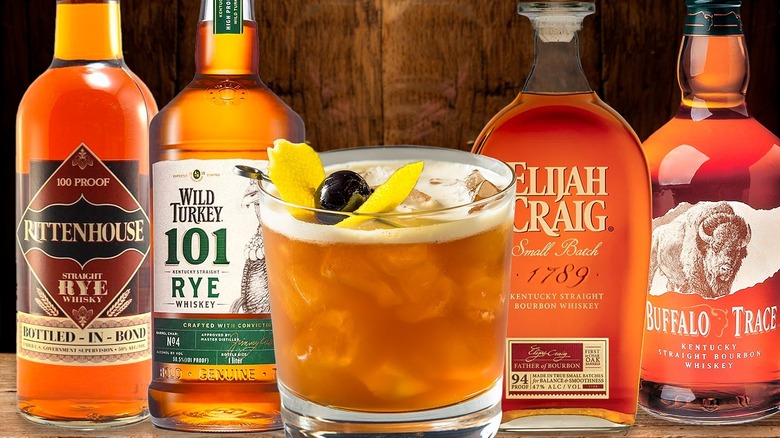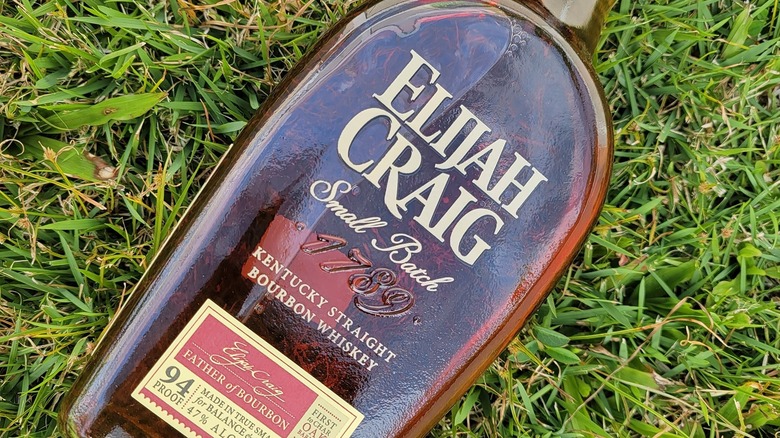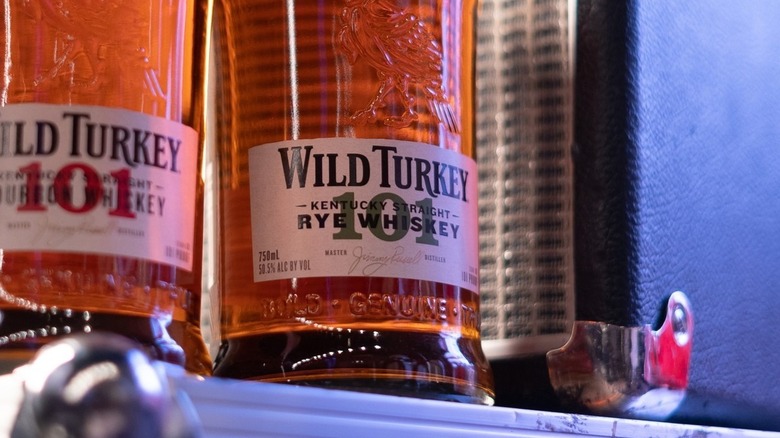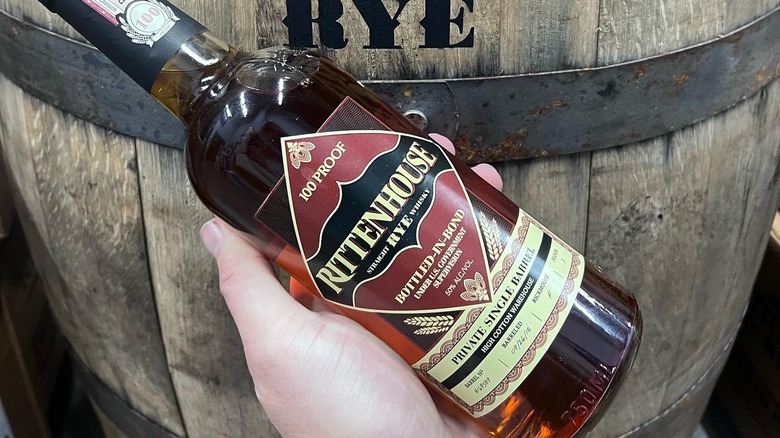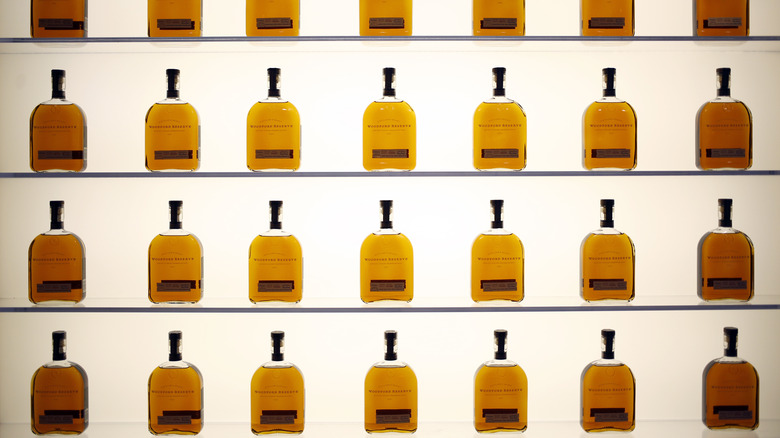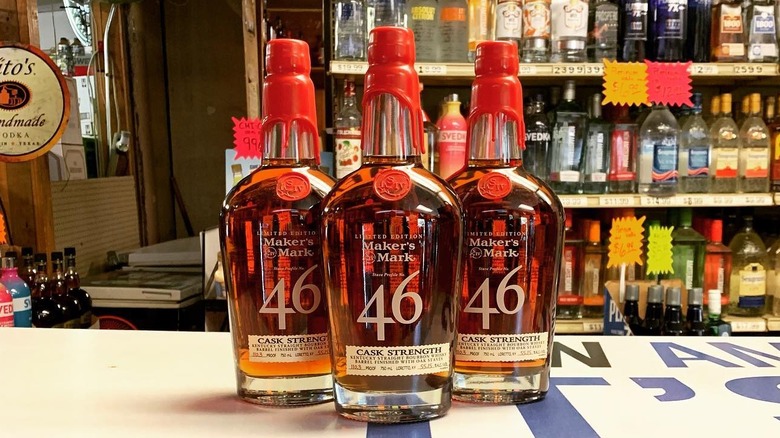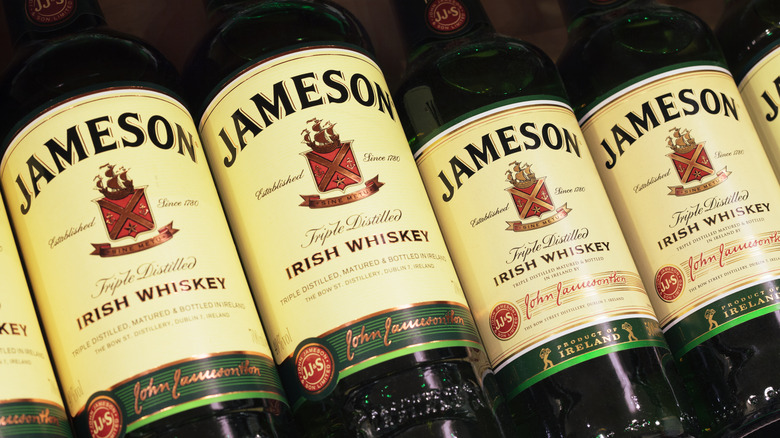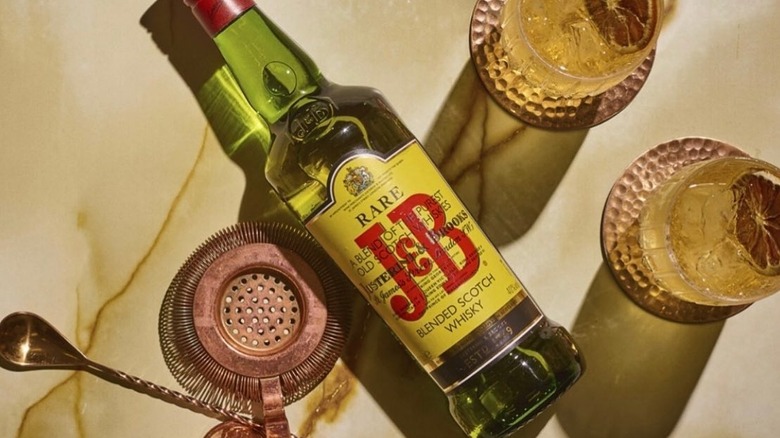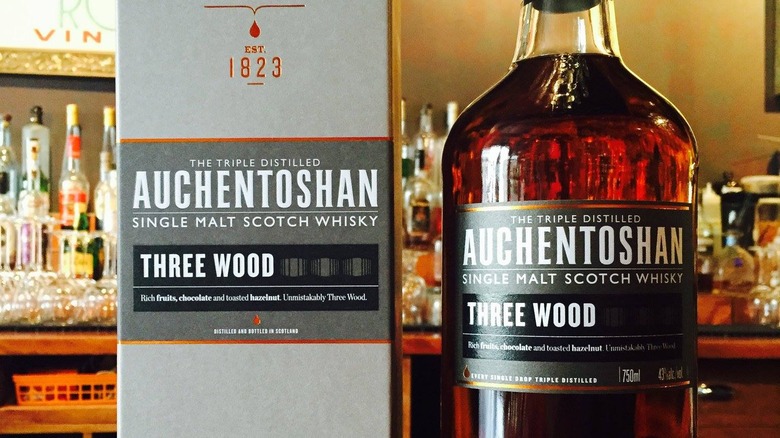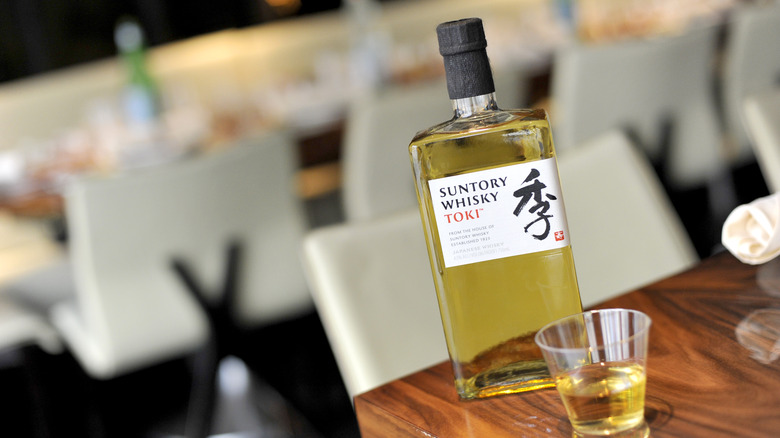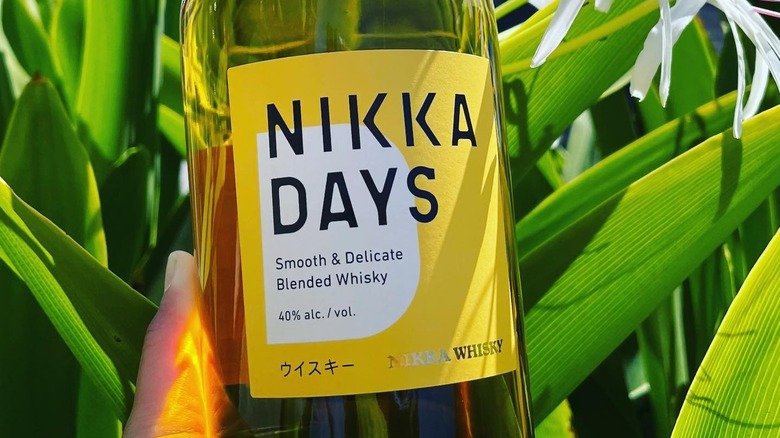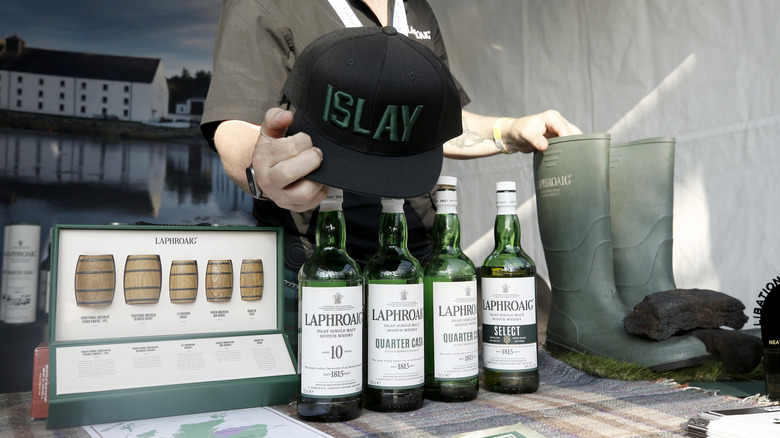12 Best Bourbons And Other Whiskeys To Use In Your Whiskey Sour
Despite being listed as an official cocktail by the International Bartender Association (IBA), the whiskey sour is often overlooked, perhaps due to its simplicity. The classic recipe calls only for bourbon, lemon juice, sugar syrup, and, optionally, an egg white.
Personally, we'd argue that egg white elevates a whiskey sour and just about any cocktail that calls for it, creating an especially creamy, frothy mouthfeel that pairs incredibly with the lightly tart, citrussy profile of the drink. If you're still not a fan of using raw egg whites, due to safety concerns or from a dietary standpoint, there are alternatives, such as aquafaba, the liquid you'll find in a can of chickpeas or similar beans. Whichever you choose, we'd always recommend using fresh ingredients for a whiskey sour.
While the simplicity of a whiskey sour might make it seem uninteresting to some, this couldn't be further from the truth. In fact, this makes it perfect for experimentation, without too many adjustments needed to transform the entire drink. A few dashes of bitters or a twist on the citrus ingredient can make a huge difference, but nothing makes quite as big an impact as playing around with the base spirit. Bourbons vary widely in terms of taste which has a knock-on effect on the overall flavor of the cocktail, and you're missing out if you don't try different styles of whiskey. Not every variant is at home in a whiskey sour, but the ones below are tried, tested, and truly delicious.
Buffalo Trace
If you want your whiskey sour to be a perfect representation of the official recipe, you'll need to pick a bourbon that's up for the task. Although Buffalo Trace is a relatively new brand, the distillery and its history stretch back for centuries, and it's a whiskey that exemplifies what a classic bourbon should be.
The high-corn, low-rye mash bill of Buffalo Trace gives it a profile of sweet caramel and molasses with strong vanilla notes, characteristics that give plenty for the cocktail's lemon juice component to cut through. There are lots of dark fruits and oak in there too, which are a staple of a well-aged bourbon and give the drink enough depth to balance out the lighter flavors in the drink. Although a whiskey sour doesn't specifically list bitters as an ingredient, a few dashes of Angostura bitters will tie all of the ingredients together, creating a more cohesive cocktail as it binds the sweet, tart, and spicy elements. The price of Buffalo Trace has seen dips and spikes over the last few years, so while it's definitely an excellent bourbon to buy, it's probably not worth picking up when it's more expensive, especially if you're planning to use it for cocktails.
Elijah Craig Small Batch
If we're talking about bourbons that exemplify the style and are appropriate for cocktails, it would be a sin to pass over Elijah Craig Small Batch. Named after a Baptist preacher who many credit as the father of bourbon by being the first to age his whiskey in new charred oak barrels, Elijah Craig Small Batch is an award-winning expression that's a welcome addition to a whiskey sour.
Compared to Buffalo Trace, Elijah Craig Small Batch is even richer and more complex. It has a slightly higher proof that adds to the mouthfeel and heat of the drink, but the extra spice is tempered by its prominent sweetness. It has notes of golden honey and creamy marzipan that work fantastically with the citrus in a whiskey sour, with heaps of oak and smoke thanks to extended barrel-aging. If you're someone who tends to prefer a higher intensity to their whiskeys, Elijah Craig Small Batch is the way forward. Plus, it's a bourbon that's stellar in other cocktails like old fashioneds and mint juleps while being strong enough to stand on its own feet as a sipping whiskey. As with Buffalo Trace, we recommend adding a couple of drops of Angostura bitters to elevate your drinking experience.
Wild Turkey 101 Rye
While bourbon and rye share many similar characteristics, there are also distinctions that make rye a superb substitution for those who prefer a bolder, spicier cocktail. As cocktail ryes go, Wild Turkey 101 Rye is another whiskey that's a standout example of its style.
For the uninitiated, there's a legal distinction between bourbon and rye whiskey — while the former has to have at least 51% corn in its mash bill, the latter has to have at least 51% rye. The differences between the two grains are noticeable in the final product, so while rye whiskeys do still have sweet and fruity aspects to their flavor profile, they tend to feature a lot more spice and citrus. Although it's considered a high-corn rye, Wild Turkey 101 Rye has these qualities in abundance, with strong notes of rye spice that burst through the vanilla and cereal-grain sweetness and add more punch to cocktails despite its relatively low proof. A lot of this whiskey's complexity also comes from the fact the barrels are "alligator" charred to the highest level, resulting in a spirit that's smooth despite its complexity, making it one of the top choices for putting a rye twist on your whiskey sour.
Rittenhouse Rye
Ask any seasoned cocktail bartender or American whiskey enthusiast their favorite rye, and you'll find most of them come back with the same answer — Rittenhouse. It's a whiskey that manages to dial the rye characteristics up to 11 despite, somewhat paradoxically, having a relatively low amount of the grain in its mash bill.
The benefit of Rittenhouse Rye is that its profile makes it perfect for balancing flavors in cocktails without being overpowering and trying to steal the show from the other ingredients. Its sweetness has a candied toffee and maple syrup essence with hints of peanut, and plenty of spice, including notes of nutmeg, cinnamon, and sweet peppers. At 100 proof, it's also got a lot more kick than other popular ryes. While Angostura is a great choice of bitters to add to your recipe, resulting in a Manhattan-like profile, there are other bitters out there that can do a better job of marrying flavors without overamplifying them. Peychaud's bitters, for example, has a slightly less punchy profile but features strong orange, anise, and candied cherry components that interplay more interestingly with the rest of the whiskey sour ingredients. What's more, Rittenhouse Rye is another whiskey that's both affordable and versatile, making it a must-have bottle for cocktails that you can just as easily enjoy unadulterated — neat or on the rocks.
Woodford Reserve
Woodford Reserve is cut from the same cloth as Buffalo Trace and Elijah Craig when we're considering classic bourbons, being of excellent quality while remaining in an affordable price range. However, there are a few things that set it apart from the others.
Woodford's sweet characteristics have a lot more weight to them, so the lighter notes of vanilla and caramel bow down to flavors of rich dried fruit, indulgent toffee, and decadent dark chocolate. There's also a leathery, tobacco-spice side to the whiskey, one that's countered with a complex citrus profile of warmed oranges and zingy lemon. Typically, Woodford Reserve probably serves an Old Fashioned better than it would a whiskey sour, but this is where you can make things interesting. Rather than sticking to the classic recipe, try using Woodford in a New York Sour instead – a twist that floats half an ounce of dry red wine on top of the sour once it's been strained into the glass. The bourbon's more mature flavors meld fantastically with those in the wine, and you can choose which direction you want the taste to take. To highlight the sweet and fruity notes, pick a wine like gamay or zinfandel that shares these qualities; to deepen the leathery, spicy notes, go for a splash of robust cabernet sauvignon or smooth merlot.
Maker's Mark 46
The standard expression of Maker's Mark should never be overlooked as a stellar cocktail bourbon – it's got enough character to shine in almost any mixed drink without any overtly unique qualities that might not meld as intended, and it's still a fine sipping whiskey. However, if you're aiming to make a whiskey sour that's simply more interesting, Maker's Mark 46 is the version to go for.
Launched in 2010, Maker's Mark 46 was the first new expression from the distillery since the original back in 1958. So, what's so special about Maker's Mark 46 that made the company feel it was time to expand their range? Although it's aged longer than standard Maker's which definitely does have an impact on the overall taste, the barrels are also fitted with specially seared French oak staves before the bourbon is fully matured. From a flavor perspective, the additional aging makes the whiskey smoother and adds more barrel character, while the staves contribute a notable amount of vanilla and baking spice. Don't forget, one of Maker's Mark trademark features is that the mash bill is topped up with red winter wheat rather than the usual rye grain. Wheated bourbons have a much creamier mouthfeel than rye bourbons, something that's absolutely ideal for sour-style cocktails that use egg white to create an airy, frothy texture.
Jameson
It's now time to move away from our American whiskeys and see what else the world has to offer that can make a truly brilliant sour. First, we're going to turn to arguably the most renowned Irish whiskey, Jameson.
Jameson is an excellent choice because Irish whiskeys are triple-distilled, whereas most other styles are only distilled twice. Triple-distilling results in a smoother whiskey that's generally more approachable (and best for beginners), making it perfect for when you want to taste the spirit without it being the star of the show. Its mellow, velvety profile means Jameson lends itself superbly to a whiskey sour's frothy mouthfeel, and it's also a better choice if you're after a less sweet cocktail, due to the lack of corn in the mash bill. Another reason Jameson works is that it's distilled in ex-bourbon barrels, as well as ex-sherry casks, meaning it shares many of the same flavors as American whiskey – creamy vanilla, dried fruits, and toasted oak are all still present, meaning we're not straying too far away from the classic recipe. However, you might want to try using lime juice instead of lemon juice, or a combination of the two, to sharpen up the drink's citrus component. In terms of bitters, try using an orange-flavored tincture to highlight Jameson's fruitier side.
J&B Rare
Next, it's time to give scotch a try. Scotch whisky can vary greatly, with some regions being known for specific styles, with some lending themselves better to a whisky sour than others. The Speyside region of Scotland is home to more whisky distilleries than any other, meaning it's also where you'll find the largest variation. However, our pick is J&B Rare, a blended scotch that embodies a well-blended, well-balanced whisky from the area, much in the way Buffalo Trace exemplifies a typical, quality bourbon.
J&B has got plenty of malted barley character that's synonymous with scotch, subtle hints of orange, and a gentle smokiness, plus the familiar toffee, honey, dried fruit, and oak characteristics. All in all, this profile makes it stand out as a delicious and affordable scotch that's completely at home in a whiskey sour. While you can easily stick to the standard recipe, there are a few modifications you can make to highlight the scotch-based variant's flavors. A pinch of salt will enhance the perceived sweetness of your drink, making up for the sweetness that's lost from not using bourbon, while balancing out any bitterness. You can also experiment with different sugar syrups — try making your own Earl Grey tea syrup to lift J&B's herbaceous aspects and make the citrus really pop.
Auchentoshan Three Wood
Although the Lowlands whisky-producing region of Scotland is the second largest by area, today, it's home to just a handful of distilleries. The best known of these is likely Auchentoshan, a brand that stands out due to the fact it triple distills its whiskies like they do over in Ireland.
Auchentoshan's whiskies are pretty typical of the region, being fresher, fruitier, and smoother than those from elsewhere. For a whiskey sour, their Three Wood expression is an excellent place to start. The name comes from the fact the distillate is matured in three types of cask — first, American bourbon barrels, then Oloroso and Pedro Ximenez sherry casks, both from Spain. The finished product is a delightfully complex yet easy-drinking whisky, with notes of butterscotch, toffee, and dark chocolate. There's a lot going on fruit-wise too, with brandied cherry and stewed dark fruit flavors. You'll still know you're drinking a Scotch, but this one's a little less rough around the edges with a richer profile, no peat smoke, and an abundance of oaky character thanks to the aging process. However, due to its Jameson-like smoothness, this is another whisky that benefits from the sharpness of lime juice when you're shaking up your sour.
Suntory Toki
Heading far away from the British Isles, we now find ourselves in Japan, a country that has only recently become renowned for the quality of its whiskies. The history of whisky in Japan is an interesting one, in the sense that its modern iterations are heavily influenced by the scotch tradition.
However, despite the obvious scotch influence in Japanese whiskies, there's a delicateness to Japanese whiskies that's emblematic of the region. While the Japanese whisky market took a bit longer to gain traction internationally, when it boomed, it boomed. As demand soared, stocks ran low, meaning the available offerings tend to swing between hard-to-find, expensive whiskies, and younger, harsher whiskies of a lower quality. Fortunately, there are whiskies like Suntory's Toki that are neither of these. Produced by the company that introduced the western-style of whisky to Japan, Toki showcases its inherited characteristics but with a notably refreshing citrus profile and touches of lightly spiced fruits which are the perfect flavor match for a lighter, brighter whisky sour. Given the refreshing nature of the cocktail, Toki is a great choice if you want to avoid a spirit that might make your sour too heavy but can still hold its own against the drink's other ingredients.
Nikka Days
While Suntory is undisputedly the biggest name in Japanese whisky, having become so prominent that it purchased the entire Jim Beam brand a decade ago, there's one other company that shares domination of the whisky market — Nikka. Nearly as old as Suntory, Nikka also formed with the desire to bring scotch-influenced whisky to Japan.
Although the Nikka range has plenty of offerings, for a whisky sour, Days is the one to pick. It's an affordable blend of single malt whisky from Nikka's Yoichi distillery and grain whisky from their Miyagikyo distillery. It shares many characteristics with a typical Speyside scotch, showcasing fresh floral notes and plenty of crisp, orchard fruits. It's milder than scotch, and while it's a gentler whisky than Suntory Toki, the key is to put a Japanese-inspired twist on your cocktail to add depth and up the intensity. First, try using ginger syrup instead of standard simple syrup to spice up the drink and thicken the mouthfeel. You can also split the citrus element, replacing some of the required lemon juice with yuzu juice, which adds a unique aromatic touch and a grapefruit-like tartness to the cocktail. For the bitters, try something moderately fragrant like elderflower bitters to enhance the drink's floral qualities.
Laphroaig 10 Year
Okay, hear us out. If you're familiar with Laphroaig 10 Year, you'll know it as an extremely intense dram that takes all the characteristics we associate with Islay whiskies and pushes them as far as they can go.
That means we're talking about a real peat bomb here, with massive amounts of earthy smoke, sea salt, brine, and a medicinal, iodine-like quality. It has a slick, oily mouthfeel, and, truth be told, it's something of an acquired taste. Now, we wouldn't recommend using Laphroaig as the sole base spirit for a whisky sour, as its flavors are simply too powerful to balance out the rest of the ingredients. That being said, you can split the base with another, less in-your-face scotch, like J&B, to even things out a bit. By adding ginger to whiskey sour or swapping out the sugar syrup for ginger syrup, you've effectively made yourself a frothy, sour take on the classic Penicillin cocktail, which itself is akin to a chilled, boozy hot toddy. If you find the flavors are still too strong, there's another little cocktail hack you can try – decant a little bit of Laphroaig into a miniature spray bottle and give your scotch-based sour a few spritzes on top to imbue it with that deep peaty aroma without interfering heavily in the overall taste of the drink.
